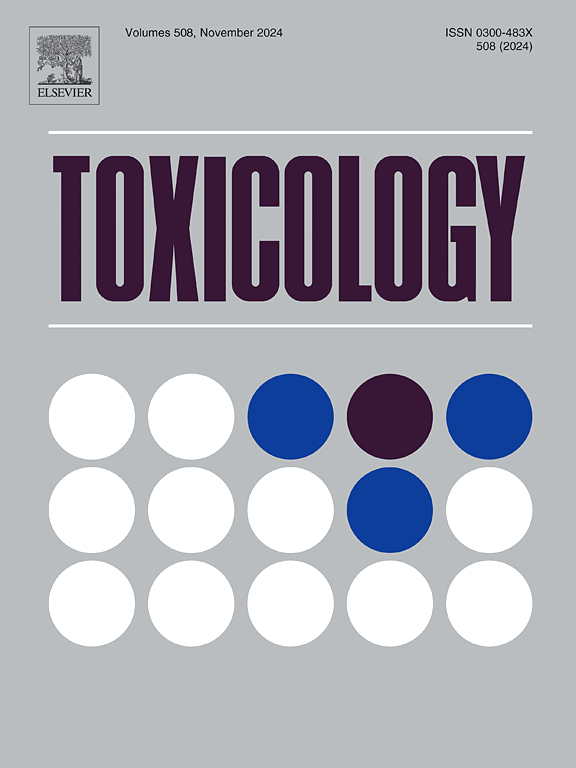体外测试电池用于检测化学诱导的胆汁淤积的分子启动事件
IF 4.6
3区 医学
Q1 PHARMACOLOGY & PHARMACY
引用次数: 0
摘要
胆汁淤积性肝损伤是一种复杂的逆境导致的毒性积累。有毒的胆汁盐在肝脏和体循环。胆汁淤积症可以由来自几个适用领域的过多化学物质引起。目前的努力未能预测化学物质的抑胆潜能,至少部分原因是对这类逆境的机制理解存在差距。最近引入的一种利用人工智能生成的胆汁淤积性肝损伤的不良结局通路(AOP)网络,将转运蛋白改变、胆小管改变和肝细胞改变作为分子启动事件(MIEs)。本研究将AOP网络作为预测胆汁淤积性肝毒性的体外测试电池的机制基础,包括监测正弦摄取、小管外排和基底外侧外排极转运蛋白变化以及胆小管变化的检测。为此,人类HepaRG细胞暴露于已知的胆汁淤积化学物质中,包括各种MIEs,非胆汁淤积性肝毒性化学物质和非肝毒性化学物质。MIE测试电池的后续应用显示出识别胆碱抑制化学物质的巨大潜力,同时正确预测所有阴性对照化学物质。综上所述,建立的体外测试电池具有早期预测胆汁淤积物的潜力。本文章由计算机程序翻译,如有差异,请以英文原文为准。
In vitro test battery for testing molecular initiating events in chemical-induced cholestasis
Cholestatic liver injury is a complex adversity leading to the toxic accumulation of.noxious bile salts in the liver and systemic circulation. Cholestasis can be instigated by a plethora of chemicals originating from several applicability domains. Current efforts fail to predict the cholestatic potential of chemicals due to, at least in part, gaps in the mechanistic understanding of this type of adversity. A recently introduced adverse outcome pathway (AOP) network on cholestatic liver injury generated using artificial intelligence pulls up transporter changes, bile canalicular changes and hepatocellular changes as molecular initiating events (MIEs). The present study used this AOP network as the mechanistic basis for the development of an in vitro test battery to predict MIEs of cholestatic hepatotoxicity, including assays to monitor transporter changes at the sinusoidal uptake, canalicular efflux and basolateral efflux pole as well as bile canalicular changes. For this purpose, human HepaRG cells were exposed to known cholestatic chemicals covering various MIEs, non-cholestatic hepatotoxic chemicals and non-hepatotoxic chemicals. Subsequent application of the MIE test battery shows great potential for identifying cholestatic chemicals, while correctly predicting all negative control chemicals. In conclusion, the established in vitro test battery shows potential for early prediction of cholestatic chemicals.
求助全文
通过发布文献求助,成功后即可免费获取论文全文。
去求助
来源期刊

Toxicology
医学-毒理学
CiteScore
7.80
自引率
4.40%
发文量
222
审稿时长
23 days
期刊介绍:
Toxicology is an international, peer-reviewed journal that publishes only the highest quality original scientific research and critical reviews describing hypothesis-based investigations into mechanisms of toxicity associated with exposures to xenobiotic chemicals, particularly as it relates to human health. In this respect "mechanisms" is defined on both the macro (e.g. physiological, biological, kinetic, species, sex, etc.) and molecular (genomic, transcriptomic, metabolic, etc.) scale. Emphasis is placed on findings that identify novel hazards and that can be extrapolated to exposures and mechanisms that are relevant to estimating human risk. Toxicology also publishes brief communications, personal commentaries and opinion articles, as well as concise expert reviews on contemporary topics. All research and review articles published in Toxicology are subject to rigorous peer review. Authors are asked to contact the Editor-in-Chief prior to submitting review articles or commentaries for consideration for publication in Toxicology.
 求助内容:
求助内容: 应助结果提醒方式:
应助结果提醒方式:


